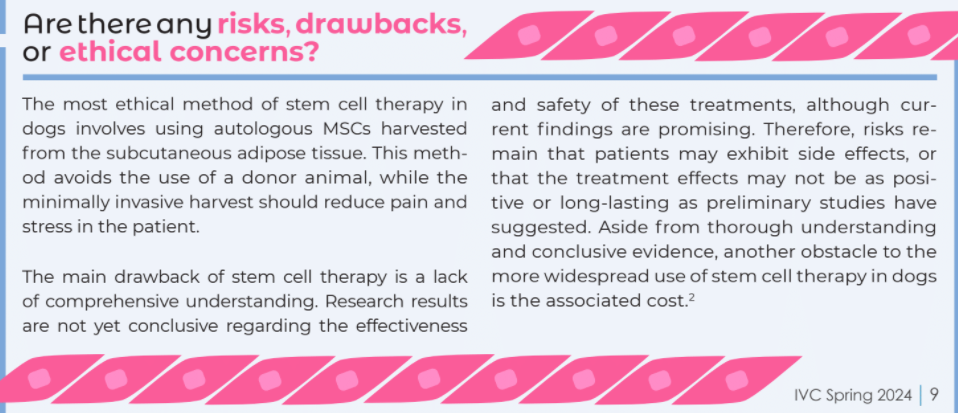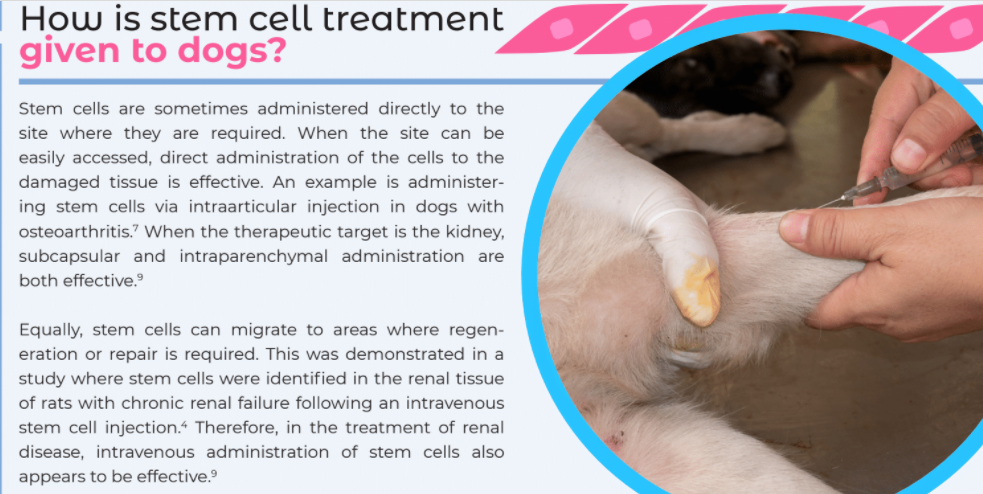Though further studies are required, regenerative medicine using mesenchymal stem cells is a potentially effective alternative to organ transplantation in dogs, and could significantly improve the prognosis of conditions like chronic renal failure and hepatic fibrosis.
When treating organ failure in dogs, whether kidney or liver, our primary goals have been to support remaining functional tissue and prevent further damage. The liver has a better natural capacity for healing and regeneration than the kidneys; in the latter, damaged nephrons do not regain function, and the remaining healthy tissue has to compensate to avoid azotemia and clinical signs. However, recent advancements in regenerative medicine have shown promise for its use in organ failure as well as musculoskeletal pathologies. This article aims to give a clear overview of stem cell use in dogs, outlining current research, clinical applications, and future prospects, while addressing limitations and ethical considerations.
What is regenerative medicine?
Regenerative medicine for organ failure in dogs involves encouraging the growth, repair, or replacement of damaged or diseased cells, tissue, or organs to restore function1,2 It aims to provide the necessary tools and building blocks, create the optimum environment for tissue growth and repair, or stimulate the bodys normal healing processes. To achieve this, stem cells and plate-rich plasma may be used.
What are stem cells?
Stem cells are undifferentiated cells that can self-renew and have the potential to differentiate into cells from different lineages.1,3,4 This means that, depending on influencing factors in their environment, these cells can become functional tissue in various body organs. The therapeutic use of stem cells was first proposed in 1991 by Caplan.1 Stem cells are increasingly used in human medicine, but despite their potential, their use in veterinary medicine has primarily been limited to treating equine and canine musculoskeletal conditions.
There are two broad types of stem cells — embryonic stem cells, which facilitate the development of various cell lines to create fetal tissues, and adult mesenchymal stem cells (MSCs),4 which allow continued regeneration, maintenance, and repair. Since MSCs can be easily harvested, isolated, and cultured without ethical concerns, these are the most appropriate and commonly used therapeutic stem cells.1,5
Where are mesenchymal stem cells found?
MSCs have been demonstrated in various tissues of common companion animal species, including the bone marrow, adipose, and dental tissue, and tissues of the joints, bones, muscles, umbilicus, placenta, uterus, and oral cavity.1 Studies have also demonstrated the presence of MSCs in the brain, spleen, liver, kidney, lung, muscle, thymus, and pancreas of mice,6 leading to the reasonable conclusion that MSCs may exist throughout all tissues and organs.
Where are mesenchymal stem cells harvested from?
Despite the many potential sources of MSCs, relatively few are currently used as harvest sites. The most commonly-used are bone marrow and adipose tissue. MSCs can be harvested from adipose tissue relatively easily with a minimally invasive procedure, and the cells retain their quality and ability to replicate, making this site preferable.7
The type of adipose used for stem cell harvest makes a difference. Studies show that MSCs from subcutaneous adipose tissue have better proliferation and osteogenic potential, and remain multi-purpose for longer, than MSCs from visceral adipose tissue.5 Harvesting subcutaneous adipose tissue is also far less invasive than harvesting visceral adipose tissue, further supporting its position as the leading source of MSCs in dogs.5.8
Another consideration when harvesting from adipose tissue is cell availability, which is affected by body condition score.8 Omental adipose tissue has been suggested as a preferred site for MSC harvest, since an appropriate amount of adipose tissue will be present regardless of body condition score.8 Furthermore, this site delivers high cell yield and good proliferation and paracrine potential.8 Since MSCs are not just effective as a source of new cells for regeneratng damaged tissue, but also have an immunomodulatory and anti-inflammatory effect, this paracrine function can enhance the success of stem cell treatment by altering the local environment.1,4
Do stem cells have to be harvested from the dog receiving the treatment?
Stem cells can be autologous (donor and recipient are the same animal),7 allogeneic (donor and recipient are different animals, but the same species), or xenogeneic (donor and recipient are different species).1 Autologous stem cells are ideal and the most commonly used; however, the process of isolating and expanding the stem cells is costly and takes time. Equally, if the recipient dog is sick or elderly, their stem cell quality may be affected. For this reason, the use of allogeneic stem cells from young and healthy donors is becoming increasingly popular, despite the risk of triggering an immune response if the cells are recognized as non-self. Just as with blood transfusions in dogs, a single allogeneic treatment is unlikely to cause a reaction, but a reaction would be more likely if treatments are repeated.1
How are stem cells currently used in veterinary medicine?
In veterinary medicine, stem cell therapy was initially used for tendon injuries in horses, but more recently it has been used to treat musculoskeletal conditions in dogs,2,10 such as osteoarthritis and spinal cord injuries.11 Their use in canine arthritis is widely confirmed in the literature, including an Italian study that demonstrated the clinical benefit of stem cell use in dogs with elbow osteoarthritis; the study showed an initial reduction in clinical signs and longer-term improvement in joint health.7
What are the potential future uses for stem cells in dogs?
Thanks to the ease and minimally invasive nature of harvesting, the abundance of stem cells within each patient, and the positive clinical results of current therapy, stem cells doubtlessly represent an exciting prospect for the future capabilities of veterinary medicine. MSCs show promise as a possible therapeutic option for many animal diseases, such as orthopedic, dental, gastrointestinal, hepatic, renal, cardiac, respiratory, neuromuscular, dermal, olfactory, and urogenital conditions.1

What does the evidence say about stem cell use for organ failure?
Rodent models have confirmed the therapeutic benefits of stem cells for improving renal structure and function in acute renal injuries.9 However, in the majority of studies, stem cell therapy was provided soon after partial nephrectomy, which does not replicate the timeframe in which pet owners would seek veterinary advice, investigation, and referral for dogs with chronic renal failure.9 The effectiveness of stem cell use in chronic renal failure is not as well documented, but rodent models show improved renal parameters on biochemistry and improved appearance on histology.4,9 Therefore, a larger bank of research is required, particularly in companion animal species, to confirm stem cell effectiveness for kidney disease, especially chronic renal failure. It is also worth noting that, to be as effective as possible in treating end-stage renal failure, decellularization may be required to remove the non-functional, damaged cells and create space for three-dimensional regeneration. This procedure has been demonstrated in canine cadavers.12
Aside from renal indications, the literature also shows promising results from stem cell treatment in canine liver cirrhosis models13 and dogs with induced hepatic injury, with improved hepatic structure and function on histology and a reduction in liver parameters on blood biochemistry.14 While the use of stem cells to treat myocardial infarction is established in humans, this condition is relatively rare in dogs.15 Currently, studies have not confirmed positive outcomes from the use of stem cells in common canine cardiac conditions. However, early studies suggest potential clinical benefits from using deciduous tooth-derived stem cells to treat valvular diseases.16
While the majority of current stem cell therapies in dogs involve autologous cells, research shows that non-autologous cells are also effective. Stem cells from both the same and different species have been demonstrated as beneficial in the treatment of acute kidney injury. One study noted the resolution of renal damage and endoplasmic reticular stress following stem cell treatment in both mice and dogs.17 Similarly, stem cells isolated from a camels Whartons jelly led to improved azotemia and a one-stage reduction in the IRIS stage in dogs with chronic renal failure.18

Conclusion
Previously, in veterinary patients with organ failure, transplantation was the only treatment option that offered hope of long-term return to function, and organ transplant surgeries are uncommon in dogs. MSCs present a potentially effective alternative to transplantation and could mark a real advancement in the prognosis of conditions like chronic renal failure and hepatic fibrosis. While research so far suggests MSCs are safe and effective, further studies are required before MSC treatment becomes commonplace for organ failure in dogs.
________________________________________________________________________
1Voga M, Adamic N, Vengust M, Majdic G. Stem Cells in Veterinary MedicineCurrent State and Treatment Options. Frontiers in Veterinary Science. 2020;7:278.
2Mocchi M, Dotti S, Bue MD, et al. Veterinary Regenerative Medicine for Musculoskeletal Disorders: Can Mesenchymal Stem/Stromal Cells and Their Secretome Be the New Frontier? Cells. 2020;9(6):1453.
3Ding DC, Shyu WC, Lin SZ. Mesenchymal stem cells. Cell Transplantation. 2011;20:5-14.
4Quimby J. Applications of Stem Cell Therapy in Kidney Disease. Veterinary Information Network. June 27, 2013. Available at: vin.com/apputil/project/defaultadv1.aspx?pId=99&catId=14649&id=6133833. Accessed February 02, 2024.
5Yaneselli KM, Kuhl CP, Terraciano PB, et al. Comparison of the characteristics of canine adipose tissue-derived mesenchymal stem cells extracted from different sites and at different passage numbers. Journal of Veterinary Science. 2018;19(1):13-20.
6Meirelles LdS, Chagastelles PC, Nardi NB. Mesenchymal stem cells reside in virtually all post-natal organs and tissues. Journal of Cell Science. 2006;119:2204-13.
7Guercio A, Marco PD, Casella S, et al. Production of canine mesenchymal stem cells from adipose tissue and their application in dogs with chronic osteoarthritis of the humeroradial joints. Cell Biology International. 2012;36:189-94.
8Bahamondes F, Flores E, Cattaneo G, Bruna F, Conget P. Omental adipose tissue is a more suitable source of canine Mesenchymal stem cells. BMC Veterinary Research. 2017;13:166.
9Stem Cell Therapy for CKD: What do we know?. IRIS: International Renal Interest Society. 2018. iris-kidney.com/pdf/Stem_Cell.pdf. Accessed February 02, 2024.
10Royal Veterinary College. Canine stem cell therapy — information for referring vets. Royal Veterinary College, University of London. 2023. Available at: rvc.ac.uk/small-animal-vet/specialist-referrals/advanced-techniques/stem-cell-clinic/information-for-vets. Accessed February 02, 2024.
11Kim EY, Kil TY, Kim MK. Case report: Amniotic fluid-derived mesenchymal stem cell treatment in a dog with a spinal cord injury. Veterinary and Animal Science. 2023;22:100318.
12Tajima K, Kuroda K, Otaka Y, et al. Decellularization of canine kidney for three-dimensional organ regeneration. Veterinary World. 2020;13(3):452-457.
13Matsuda T, Takami T, Sasaki R, et al. A canine liver fibrosis model to develop a therapy for liver cirrhosis using cultured bone marrow-derived cells. Hepatology Communications. 2017;1(7):691-703.
14Yan Y, Fang J, Wen X, et al. Therapeutic applications of adipose-derived mesenchymal stem cells on acute liver injury in canines. Research in Veterinary Sciences. 2019;126:233-239.
15Kang MH, Park HM. Challenges of stem cell therapies in companion animal practice. Journal of Veterinary Science. 2020;21(3):e42.
16El-Husseiny HM, Mady EA, Helal MAY, Tanaka R. The Pivotal Role of Stem Cells in Veterinary Regenerative Medicine and Tissue Engineering. Veterinary Sciences. 2022;9(11):648.
17He W, Qin D, Li B, et al. Immortalized canine adipose-derived mesenchymal stem cells alleviate gentamicin-induced acute kidney injury by inhibiting endoplasmic reticulum stress in mice and dogs. Research in Veterinary Science. 2021;136:39-50.
18Miniawy HMFE, Farghali HA, Khattab MS, et al. The therapeutic potential of Camel Wharton jelly mesenchymal stem cells (CWJ-MSCs) in canine chronic kidney disease model. Stem Cell Research and Therapy. 2022;13:387.



